Posted by: Ken @ 11:45 am
Good news: By late March our local heron rookery contained a total of seven nesting pairs of Yellow-crowned Night-Herons, plus three immature birds and possibly a 15th unattached male.
The rookery runs along the edge of this canal, on the opposite side of a power substation with these landscaped grounds. Across the canal, note the defoliated trees next to the water that were treated with herbicide. Last year the nests were well hidden, but now several are out over the water on dead and dying limbs.
This Yellow-crowned Night-Heron is tending its blue eggs in a nest in one of the herbicide-treated trees.
Additionally, I found two pairs of Green Herons. One pair has eggs in its nest. I could not find the second Green Heron nest, but suspected it was hidden in dense vegetation along the canal, near the south end of the rookery.
Here, the pair exchanges incubating duties.
Bad news: On the morning of March 23 Mary Lou and I made a routine visit to the local Bald Eagle nest to check on the welfare of the single eaglet. We had watched it being fed by its parents two days earlier, and the evening before it was seen on the nest. The nest was now empty. We were concerned that the eaglet was not ready for free flight.
Although it had been 68 days since ground observers deducted from a change in the adults’ behavior that the first egg had hatched, this chick was lagging about week behind an important milestone. Over the past three years that we and other volunteers have been monitoring the nest, the oldest eaglet started climbing out on branches and “helicoptering’ (hovering in place a few inches above the nest) when they averaged 67.3 days old, and they took their first flight when they averaged 75.3 days old. The interval between first observed branching/hovering and first flight was eight days for each of the first-hatched eaglets. View this chart that summarizes key events recorded by ground observers over the past four years.
This adult was photographed in happier times.
These were my last photos of the eaglet as it was being fed, taken on March 20.
More Bad news: On March 24, Steve Siegel, while visiting the rookery, found a Green Heron that had been tangled in fishing line. It was splashing in the deep water of the canal, at the north end of the rookery. He rescued it and brought it to Pelican Harbor Seabird Station in Miami. After the heron was taken to rehab, I noticed an unattached single Green Heron at the south end of the rookery, very possibly the mate of the bird that Steve had rescued. One of the herons from the pair with a nest chased it away when it flew to a tree near their nest. By the way, Steve, who was cinematographer for the Steve Martin movie “The Big Year,” has posted a short video clip of the herons displaying: Yellow-crowned Night Herons display (Hi Def)
This is the lone Green Heron. Note the proximity of the homes that line that side of the canal. It is likely that the only reason the nest trees were allowed to grow was because they shield their residences from a view of the power substation.
In the meantime, the eagle nest stood empty for almost a week, with neither the eaglet nor the adults in sight. This is most unusual. In all the other three seasons at least one adult kept watch over the newly fledged eaglets, at or near the nest site. They would bring food to the nest, in an apparent effort to entice the youngster to return. We usually could hear the calls of a downed eaglet. Although some eaglets went missing for a day or two, they always managed to find their way back to the nest, probably driven by hunger. During the past three seasons the fledglings continued to return to the nest until they were about 4 months old, to be fed, rest, and sometimes even spend the night . This time we heard no calling, and saw no evidence of parental concern.
Good news: On March 27, when the Green Heron was pronounced ready for release, I met Steve near the spot where he had found it. Steve carried it in a “pet taxi.” Steve opened the door and the heron flew out so fast that I could not get a photo.
The little heron flew across the canal and immediately began drinking water.
It then rested along the bank just under one of the Yellow-crowned Night-Heron nests in a herbicide-treated tree (Look closely– the Green Heron is at the lower right and the Yellow-crowns are at the nest in the upper left of this photo).
I watched the released heron for about a half hour, hoping to see it reunited with its mate, but it never moved very far south from where it was released. I found and photographed a single Green Heron in a thick patch of brush along the canal where a pair nested last year, but I could not see a nest.
Even more bad news: By March 30, the eaglet had still not been seen or heard, and no adults were observed in the vicinity of the nest.
I called the Florida Fish & Wildlife Conservation Commission (FWC) hotline to report our concerns. Since it was not considered an emergency, they put me in contact with Michelle Van Deventer, FWC Bald Eagle Coordinator. After concluding that the eaglet very likely had not survived, Michelle authorized me to investigate under the nest. Her instructions were that if we discovered any eagle remains, we were not to touch them and to call FWC, as a forensic examination would need to be conducted to determine the cause of death.
I had earlier obtained permission from the City of Pembroke Pines, owner of the land, to enter the nest area, and notified the head of Public Works of my intention to walk out to the nest.
Fellow volunteer eagle watcher Al Griffin and I arrived in the area of the nest before 8:00 AM that morning. As has been the case, neither adult nor young Bald Eagles were seen or heard. Al had already set up two ladders which provided a way to get over the fence directly in front of the nest tree. He also had a small chain saw which allowed us to get through the tangle of Melaleuca saplings, Brazilian Pepper shrubs and vines that are especially thick at the edge of the wooded property.
Al, who serves with me on the Mayor’s Bald Eagle Sanctuary Steering Committee, is a retired firefighter and is always prepared. He had parked his pickup truck off the roadway in an no-parking area, but put up traffic cones and even one of those small traffic control horses.
We had to hack our way about 20 yards before entering a more open area populated by larger Melaleucas and Sawgrass. There were areas of standing water and mud. These are the roots of a large Australian Pine that was toppled during Hurricane Wilma. Since the eagle nest is in the same species of tree, it is vulnerable to being uprooted in a wind storm.
The area immediately around the nest tree was somewhat clearer.
We carefully searched a circular area about 50 feet around the nest, and found many prey remains– feathers of white and black and white birds, probably adult and immature White Ibis, and possibly egrets. We found no bones, but they likely were carried off by scavengers such as rats, mice, Opossums, Raccoons, Gray Foxes and Bobcats. A few feathers were white with brightly iridescent black areas that may have come from a Wood Stork or possibly a Muscovy Duck. However, there was no evidence of a dead eaglet. Of course, it too may have been scavenged. Nearly all the contour feather we found were white, and they were more concentrated to the west of the nest tree, not surprising in view of the prevalent easterly winds.
Only this 17 inch quill appeared to have belonged to an eagle. It showed signs of wear and bleaching and probably had recently been molted by one of the adults. I informed the FWC agent and was told they would not retrieve it unless we found a dead eagle or received a complaint the the eagle had been disturbed or killed. I moved it to a more protected spot in the event that an official of one of the American Indian tribes wanted to retrieve it.
Although we had cleared our activity with the City, we forgot to notify the police! After about two hours of searching the nest area, three police patrol cars showed up, lights flashing. The officers were cool and interested in what we were doing, as the eagle watchers are a common fixture along the roadway in front of the nest. An alert bicyclist passing by the nest had called them after seeing our vacant vehicles and hearing us in the woods. Al and Trisha, another member of the Mayor’s Committee, handled the cops while I worked my way to the southwest, generally following a line along which the prevailing winds had blown more feathers. This brought me into the heart of the stand of herbicide-killed Melaleuca trunks where the eagles often roost. It also provided a panoramic view of the west side of the “eagle forest.” I scanned the treetops for signs of the eaglet, as we did a couple of years ago when one went missing and we found it “tree-hopping” back to the nest. No such luck this time, and likewise the areas around the larger and favored roost trees were clear.
The “Melaleuca Graveyard.” Occupying a tract that is owned by the South Florida Water Management District, these trees were killed by herbicide several years ago in order to improve the habitat for native Everglades vegetation. The wooded area that includes the eagle nest is to the right.













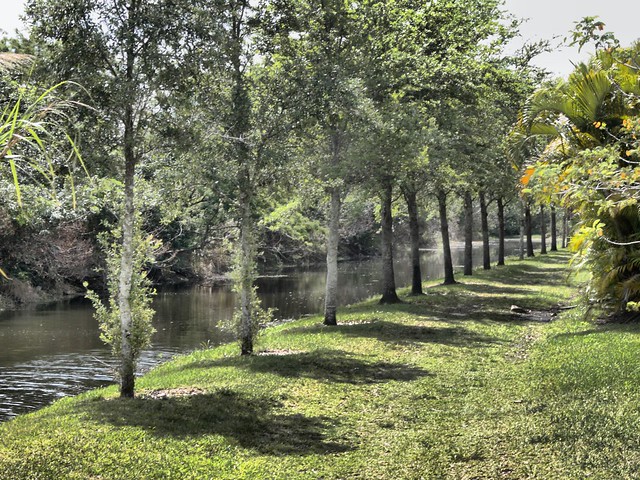

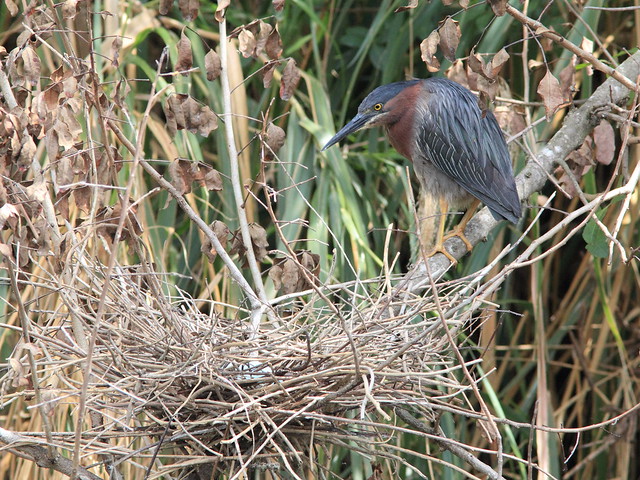
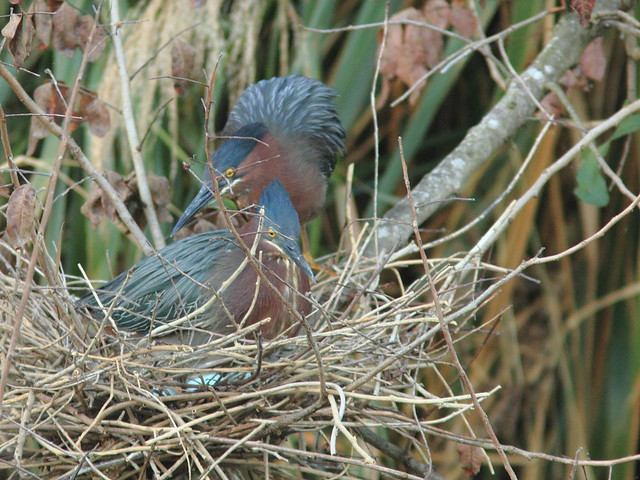

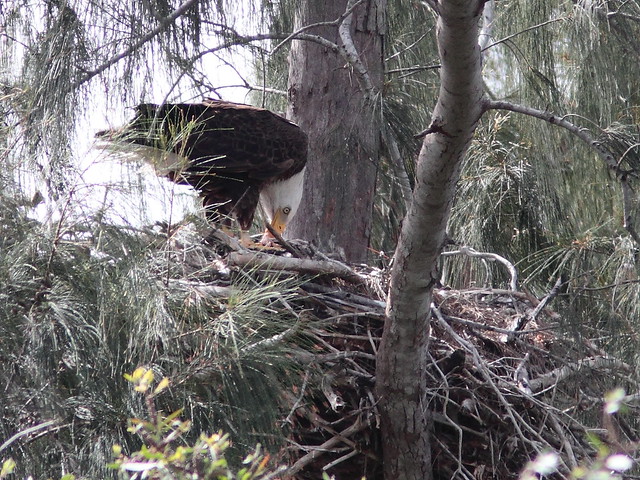
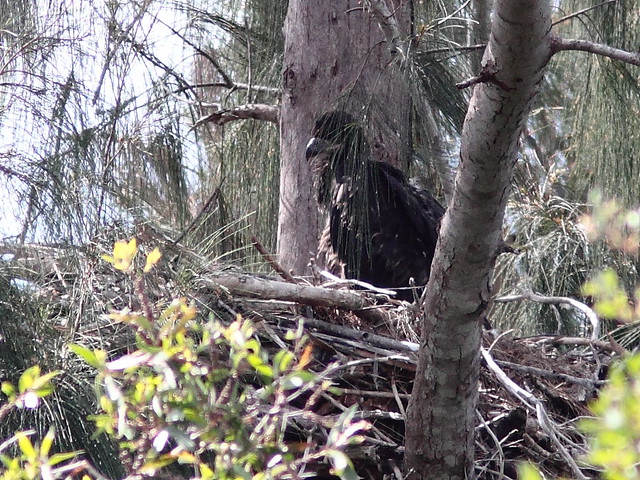
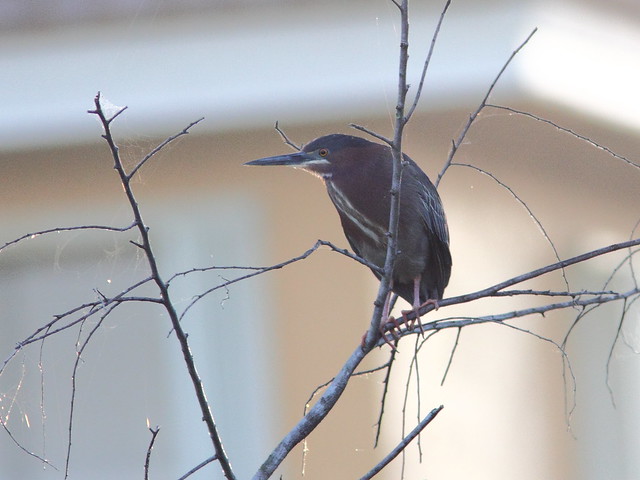
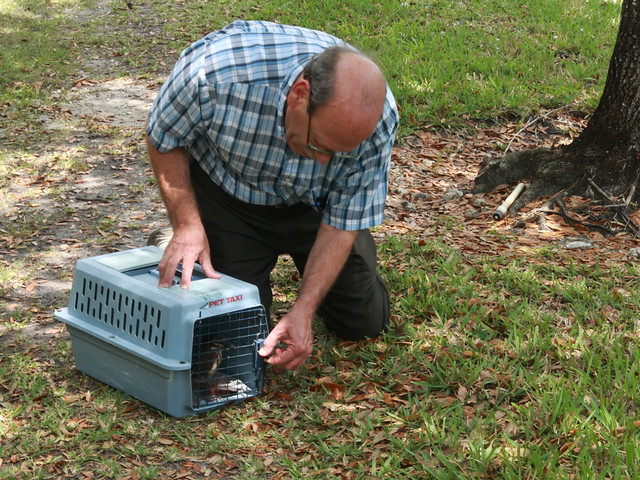
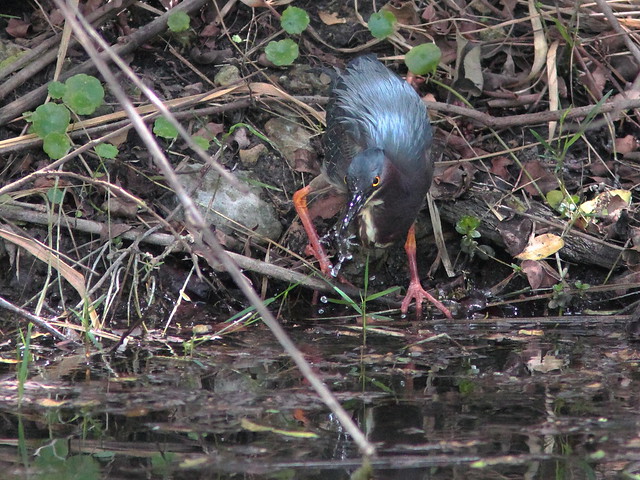
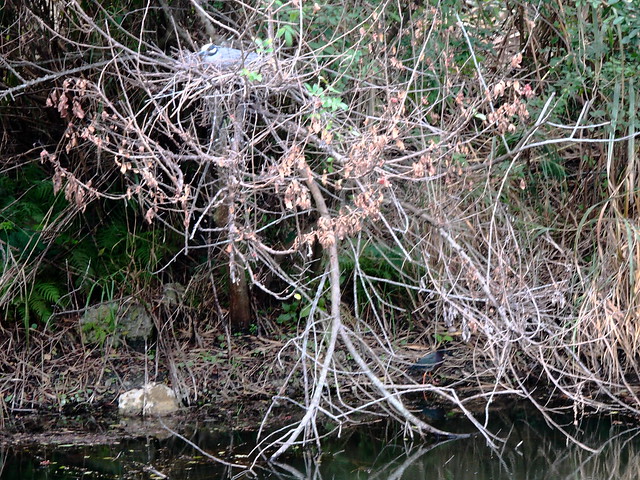
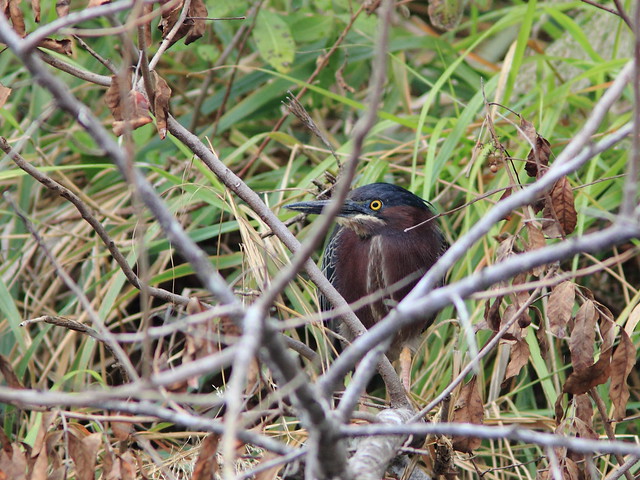
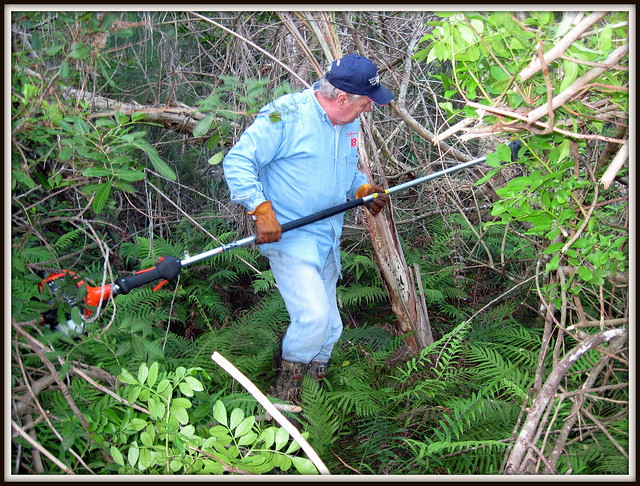
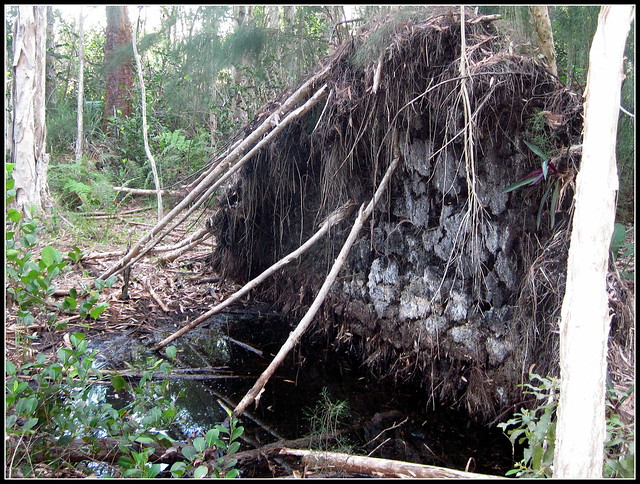
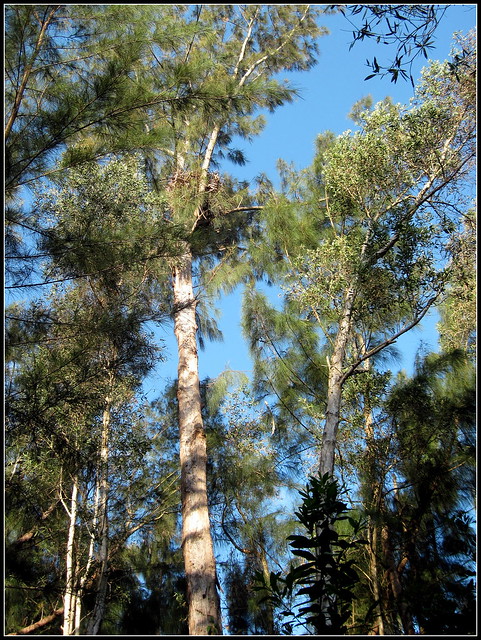
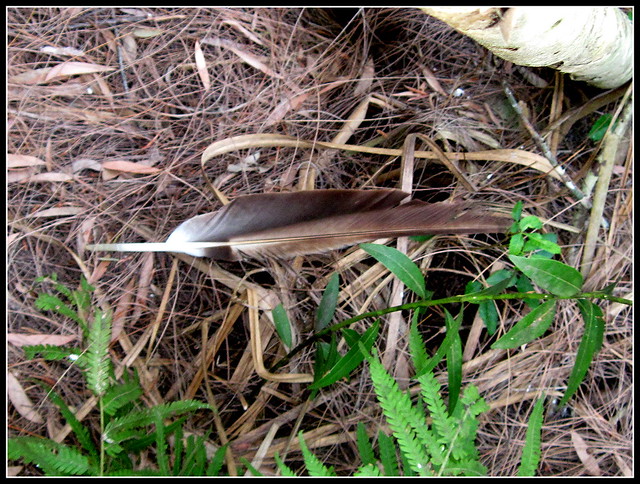

April 3rd, 2012 at 12:12 pm Great post!! Hope the Eaglet is OK!! Boom & Gary of the Vermilon River, Canada.
April 3rd, 2012 at 1:12 pm Great post! The herons is so beautiful! and the photos of the eagle is amazing! How nice to see it so close.
April 3rd, 2012 at 5:19 pm Very commendable work Ken! I hope the young one turns up alive somewhere. Isn’t it possible that it fledged earlier? I know sometimes Bald Eagles fall during their maiden flights but I would think that you would have found evidence to that effect. On the positive note, the shots of the herons are fabulous! I find that Green Herons can be very elusive. How is the defoliation affecting the birds?
April 3rd, 2012 at 6:24 pm WOW, this is an awesome post! Excotic birds with great colours! Happy WBW to you!
April 3rd, 2012 at 6:50 pm Ken, I am sorry about the eaglet. A sad loss! But, there was happy news with the release of the Green Heron. Great post and wonderful photos.
April 3rd, 2012 at 10:39 pm Very interesting post but bad news about the young eagle. Do you have any ideas about what might have happened to it? Do eagles like that have predators? I think you should do a follow up post about this please. I hate herbicide clearing! I think it should only be used if native species are replanted as soon as possible!
April 3rd, 2012 at 11:01 pm Great shots as always, Ken! That first eagle photo is fantastic!
April 3rd, 2012 at 11:39 pm Such a fascinating post Ken. The work your doing with Bald eagles is a lot more regulated than I would have imagined. I wish your story had had a happier ending but that certainly shows the value of your observations in the effort to help establish a healthy, diverse eagle population.
April 4th, 2012 at 4:23 am Thank you all for your comments. Larry and Mick’s concerns about defoliation are well-placed. My most immediate concern is that the heron nests that are out on the bare branches are exposed not only to predators, but to the eyes of rock-throwing kids. Further, there is no attempt on the part of the Water Management District to replace native trees along the canals. While most of the vegetation is exotic Brazilian Pepper, there are also Trema, Lantana and native Ligustrum. Herbicide is also applied to the native water plants that grow along the edge of the water. All this is done to permit the banks and levees to be more easily inspected. It has been the habit of the adults to feed the eaglets at the nest for up to two months after fledging. Certainly this is more efficient than having to keep track of and bring prey to two or three at different locations. As for the eaglet’s fate, hope springs eternal. Since there was only one surviving chick this year, perhaps the adults followed it and are guarding and feeding it at a remote location. I will plan to provide updates. Things are happening so fast that I may have to break my resolve to only post once a week. Springman, now that the eagle nest has been producing offspring for at least five years, we may expect that birds from earlier broods will start looking for nesting territories in this general area. The parents have been seen chasing away immature eagles that sometimes appear at or near the nest tree. They are said to defend a territory of 1-2 miles around the nest. Where will these additional eagles find suitable breeding locations?
April 4th, 2012 at 4:32 am @Mick: When very young the eaglets are particularly vulnerable to predators such as Great Horned Owls, Fish Crows and Raccoons. The adults usually stand watch at or near the nest during that period of time. After 6-8 weeks of age they probably can put up a good fight against any nest invaders. If grounded, an eaglet can escape by climbing up on branches, but if injured and still too small it easily falls prey to Bobcats, foxes, alligators and Raccoons.
April 4th, 2012 at 4:35 am Greetings from Oman!!! Great images of the eagle and herons…will be back for more:) Shantana
April 4th, 2012 at 8:13 am Great post!!! (as usual…) Regards,
April 4th, 2012 at 9:11 am Really interesting post. It’s good to find out that the Green Heron was able to be released. I love your photo showing the eagle’s majestic stance on top of the tree.
April 5th, 2012 at 3:18 am Always a tragic feeling when a nest fails like this! Hopefully the adults can try again…sad for the young one though! At least the Heron made it and we can just imagine that it did reclaim it’s mate, and if not, another;’) Nature, got to love it! Happy Easter season~
April 12th, 2012 at 1:37 pm So far I have not found a second Green Heron nest, though I still see two pairs in the rookery area. I assume the pair separated by the fishing line incident have reunited. The first nest is probably the most-exposed nest in the rookery. The eggs should be hatching any day now.